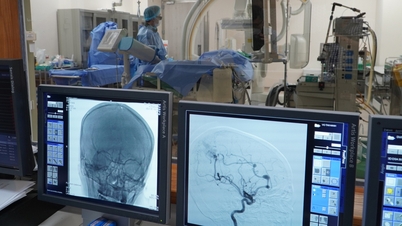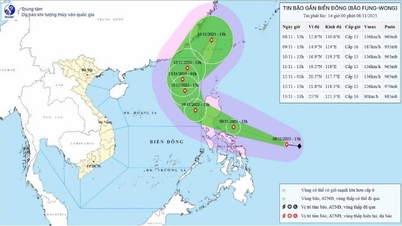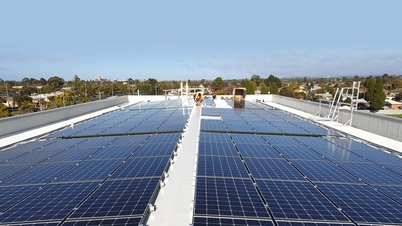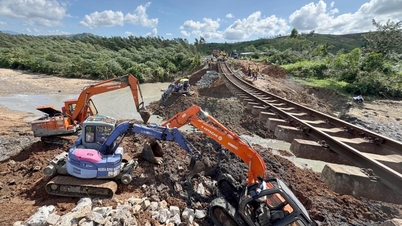13 year old girl in coma due to ruptured cerebral blood vessel while sleeping
Children's Hospital 1 ( Ho Chi Minh City) has just saved the life of a 13-year-old patient in a deep coma due to a ruptured cerebral vascular malformation, on the basis of a rare spongy cardiomyopathy.
Patient H, 13 years old, was transferred from Hoc Mon Hospital in a deep coma, on a ventilator, slow heart rate and low blood pressure. Before that, the child was sleeping when he suddenly had reverse breathing, fell into a coma and was diagnosed with suspected cerebral hemorrhage with cardiogenic shock.
At Children's Hospital 1, the patient received intensive emergency care. Echocardiography and brain CT scan showed that the right frontal arteriovenous malformation had ruptured, causing cerebral hemorrhage into the ventricles, on the background of spongy cardiomyopathy - a rare congenital heart disease.
The hospital mobilized an urgent multidisciplinary consultation. The interventional cardiologist inserted a temporary pacemaker, while the neurosurgery team performed decompression craniectomy, microsurgery to cut the vascular malformation and remove the hematoma. After surgery, the patient received intensive resuscitation, anti-cerebral edema treatment, ventilation maintenance and vasopressor drugs.
Thanks to timely treatment, the patient gradually regained consciousness, had mild weakness in his right leg, and his cardiovascular system was stable. The pacemaker was removed and vasopressor medication was discontinued. Post-operative examination images showed no more vascular malformations and heart function had significantly improved.

A cerebral arteriovenous malformation is an abnormal connection between arteries and veins in the brain.
Causes of cerebral vascular malformations
Cerebral arteriovenous malformation is an abnormal connection between arteries and veins in the brain, connecting directly without going through the capillary system.
This phenomenon can appear anywhere in the body, but is more common in the brain and spinal cord. It is estimated that only about 1% of the population has a brain arteriovenous malformation.
In addition to arteriovenous malformations, there are other forms such as telangiectasia, venous tumors, etc. The main cause is congenital, developing during fetal formation, so the disease is also called congenital cerebral vascular malformations.
Symptoms of cerebral vascular malformations
Cerebral vascular malformations often have no obvious symptoms until the first bleeding or hemorrhage occurs. According to statistics, about 88% of people with cerebral vascular malformations do not show symptoms and are only discovered by chance during health check-ups, treatment of other diseases or when bleeding has occurred.
Suspicious signs include:
- Headache
- Convulsions, epilepsy
- Difficulty coordinating limbs, muscle weakness
- Numbness, tingling, spontaneous pain
- Difficulty in communication, loss of language
- Reduced vision
- Memory loss, confusion, hallucinations
- In children: heart failure, large head, prominent scalp veins.
The disease is usually detected when the blood vessels have ruptured. Some cases are detected early thanks to imaging tests. Therefore, when there is a headache, dizziness, numbness or hemiplegia, convulsions, you need to go to the hospital immediately, cases of sudden loss of consciousness are emergency.
Diagnosis of cerebral vascular malformations
The doctor will begin with a clinical examination and symptom assessment, then order imaging tests:
- Computed tomography (CT): Fast results, often used in emergencies. Contrast dye can be injected to clearly see blood vessels and malformed structures.
- Magnetic resonance imaging (MRI): Non-invasive, provides detailed images of soft tissues, locations of abnormalities, bleeding or hemorrhage.
- Magnetic resonance angiography (MRA): Provides detailed images of blood vessels and brain structures. Contrast dye helps blood vessels appear clearly on the image, supporting accurate diagnosis.
Source: https://suckhoedoisong.vn/canh-giac-voi-di-dang-mach-mau-nao-169251107103303562.htm



































![[Photo] "Ship graveyard" on Xuan Dai Bay](https://vphoto.vietnam.vn/thumb/1200x675/vietnam/resource/IMAGE/2025/11/08/1762577162805_ndo_br_tb5-jpg.webp)



![[Video] Hue Monuments reopen to welcome visitors](https://vphoto.vietnam.vn/thumb/402x226/vietnam/resource/IMAGE/2025/11/05/1762301089171_dung01-05-43-09still013-jpg.webp)





































































Comment (0)